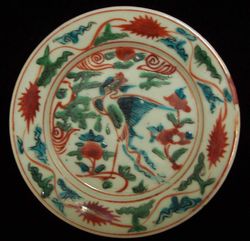Antique China Patterns
Antique china patterns are regularly or repeatedly used decorative patterns on porcelain. They do exist on porcelain for China's internal market as well as on export porcelain.
China patterns with Chinese style decorations
(as found on export porcelain)
Examples for the European market
- Kraak pattern
- Willow pattern
- Rooster pattern
- Rose medallion
- Mandarin pattern
- Imari style china patterns (see Chinese Imari)
- Fitzhugh pattern (custom made for the Fitzhugh family, initially)
- Armorial porcelain (often similar design with different initials or coat-of-arms, etc.
|
Japanese market Red-green plate |

|
Southeast Asian market
From the middle of the 19th century (Tongzhi reign) porcelain was made
to order specifically for the Straits Chinese in Malacca and Singapore,
and their descendants. See Peranakan or Nyonya Porcelain.
Thailand also had porcelain made according to their tastes. Benjaron
porcelain was initially made for the royal court, but in the 19th
century also for others.
Vietnamese upper classes too were clients for a special type of blue and
white porcelain (Bleu de Hué), specifically made for Vietnam.
Domestic market of China
A design that frequently appears in antique china patterns is the
so-called "rice-planting peasant / fisherman / firewood collector"
pattern which was used in many variations throughout the centuries.
Another one is the "floral and bird" pattern, where a garden with or
without balustrades, with or without birds, and/or flowers are depicted.
There is the "three friends of winter" (bamboo, plum and pine), scholar
designs were popular especially in the Ming dynasty, while ladies are
frequently found in Qing dynasty patterns. Children at play are found
throughout.
Scores of other patterns were in use for China's domestic market. Many
related to history, mythology and traditional events. See Craft Motifs and Chinese Symbolism.
There are many more patterns found, both in domestic and export
porcelain. In addition, Chinese china patterns can also be found in
antique European porcelain (!).
From
the 17th to 19th centuries Chinese motifs and styles were copied by
European porcelain producers to various degrees. The willow pattern is
one example of a Chinese pattern that found wide use in European
porcelain.
"Chinoiserie" is a term that many will know... it designates a.o. European porcelain imitating Chinese patterns or styles.
